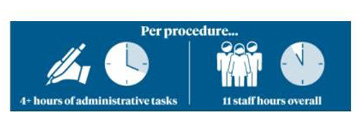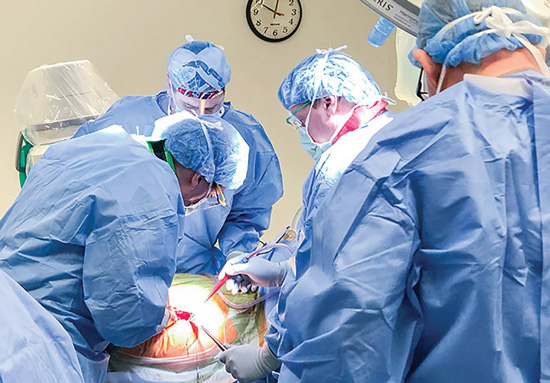It's crucial to run your growing orthopedic program as efficiently as possible to avoid delays, minimize costs and achieve patient satisfaction.
 It's important to look at reducing manual, redundant and paper-based tasks to reduce administrative burdens.
It's important to look at reducing manual, redundant and paper-based tasks to reduce administrative burdens.
Given the high-stakes nature of orthopedic procedures, it's crucial to run your orthopedic program as efficiently as possible to avoid delays and cancellations. Any improvements that can be instituted in the ASC offer the opportunity to stay competitive while growing business.
The average time and cost spent on a surgery amounts to more than four hours of administrative time and up to 11 hours of staff time overall, which accounts for more than almost 40 percent of operating expenses.1 As increasing pressures to recruit and retain staff continue to challenge ASCs, it's important to look at what can be done to maximize efficiency for orthopedic procedures.
Here are five tips that can help reduce the administrative burden and streamline workflow.
Reduce manual, redundant and paper-based tasks. Tried-and-true solutions to reducing tasks can help staff do more important things. When ordering narcotics using the DEA's paper 222 form, for example, you may want to consider a front-end user interface that automates the task and eliminates the need for paper. Automation systems may be available from your distributor for a nominal fee or no fee at all, and they can be accessed from the same system you use to place orders. Some online ordering systems also allow you to accept and approve invoices online and that helps to avoid the manual process of matching invoices, purchase orders and packing slips. Automating a three-way match with packing slips, purchase orders and invoices electronically eliminates the need to mail, fax and scan hard invoice copies.
Harness the power of kits and trays. Optimizing procedure trays is a great way to manage costs and efficiencies especially if you're doing bundles. You're probably using custom procedure trays (CPT), for your most common cases, but are you taking full advantage of the added efficiency kits and trays can bring? It may be worthwhile to do time studies on some of your less common ortho procedures to assess whether you can save time by pre-kitting them, too. Using room turnover kits can help drive consistent and efficient turnover times. By kitting standard items such as sheets and headrest covers with kick buckets and even mops, for example, the staff doesn't need to track down several items after every case.
Use data and analytics. It's difficult to improve efficiency if you're not measuring key data that have the biggest impact on the bottom line. Investing in data and analytics to improve efficiencies can help grow your margins, but accessing key data doesn't have to cost a lot. In fact, some important metrics such as performance dashboards, for example, can provide visibility into possible redundancy and waste and may be offered at no charge as part of a system.
Don't be caught off guard. Procedures such as large joint replacements use a considerable amount of instrumentation. You don't want to be caught off guard without enough instruments ready to use. It's not uncommon for an ASC to have a sterilizer that only fits two pans at one time, which can make it difficult to do larger volumes of joint replacements.
According to Delores O'Connell, senior clinical education specialist with STERIS, obtaining physician preference cards from other facilities is an excellent blueprint for assessing overall equipment and instrumentation needs for a new joint program in particular. She cautions that they may only include general procedural items such as basic orthopedic instrumentation, power equipment and retractors and in many instances they will not include vendor-specific trays for the joint implants themselves.
Typically, loaned instrument systems arrive 24 to 48 hours ahead of the scheduled case. Instrument sets that are delayed at the previous facility where used could require overtime to process.
"These types of special circumstances may require a second vendor's implant system to be held on stand-by which, can be an additional seven to 15 sets," O'Connell says.
Additionally, if a capacity study of washers, sterilizers and ultrasonics hasn't been done, a facility could find they do not have the throughput to process this number of trays effectively and efficiently. If the capacity of the equipment isn't adequate, this could require hours between cases and may not be the most effective use of surgery suite scheduling or sterile processing operations.
Not all mechanical washers, sterilizers or ultrasonic units are the same. Equipment should be designed to reprocess surgical instrumentation. Careful planning and right-sizing the equipment to maximize patient care and safety can yield a strong ROI on reprocessing equipment.
If you're planning to add a large joint procedure and want to ensure you're prepared, your distributor – working closely with equipment manufacturers' planning experts – can help assess the amount of throughput you'll need based on the expected caseload.
Reduce readmissions. With the average rate of readmission 30 days after a hip or knee replacement at 4.2%, it's important to understand the leading causes of readmission after joint procedures.2 Surgical site infections and sepsis, deep vein thrombosis and falls all lead to a poor patient experience as well as a cost burden and inefficiency, but there are ways to reduce and even prevent readmissions. Check out this detailed guide for reducing readmissions after a joint replacement for more information.
Note: For more information, please go to mms.mckesson.com/orthopedics.
References:
1. VMG Health Intellimarker Multi-Specialty ASC Study 2017
2. Hospital Compare. Data collected July 1, 2014 - June 30, 2017
 HIP CROWD Facilities looking to profit, provide positive outcomes and grow total hip replacement volume must focus on surgeon comfort, multimodal pain management and more.
HIP CROWD Facilities looking to profit, provide positive outcomes and grow total hip replacement volume must focus on surgeon comfort, multimodal pain management and more.
.svg?sfvrsn=be606e78_3)


.svg?sfvrsn=56b2f850_5)